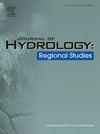Sources of hydrochemistry and chemical weathering rate at Urumqi Glacier No.1 catchment in central Asia
IF 4.7
2区 地球科学
Q1 WATER RESOURCES
引用次数: 0
Abstract
Study area
Urumqi Glacier No.1 Catchment in central Asia.
Study focus
Chemical weathering at the basin scale is important process for understanding the feedback mechanism of the carbon cycle and climate change. This study mainly used the actual sampling data in 2013, 2014, and 2016, and the first collection from the literature in same catchment to analyze the seasonal and interannual characteristics of meltwater runoff, as well as cation denudation rate (CDR).
New hydrological insights for the study region
The dominant ions of meltwater runoff are Ca2 +, HCO3-, and SO42-, which are mainly derived from calcite dissolution, feldspar weathering and sulfide oxidation. Meltwater runoff at Urumqi Glacier No.1 has higher concentrations of Ca2+ and lower concentrations of HCO3- than that from glaciers in Asia. Compared to 2006 and 2007, cation concentrations increased in 2013 and 2014, while SO42- concentration decreased. The daily ion concentration has seasonality and exhibits a negative relationship with discharge. Daily CDR is positively related to discharge and temperature. Annual CDR values range from 12.34 to 19.04 t/km2/yr in 2013, 2014, and 2016, which are 1–1.7 times higher than those in 2006 and 2007 and higher than some glaciers in Asia. These results indicate that chemical weathering rate in the Urumqi Glacier No.1 catchment has increased with climate warming, and it is stronger than that of some glaciers in the Tibetan Plateau and surroundings.
求助全文
约1分钟内获得全文
求助全文
来源期刊

Journal of Hydrology-Regional Studies
Earth and Planetary Sciences-Earth and Planetary Sciences (miscellaneous)
CiteScore
6.70
自引率
8.50%
发文量
284
审稿时长
60 days
期刊介绍:
Journal of Hydrology: Regional Studies publishes original research papers enhancing the science of hydrology and aiming at region-specific problems, past and future conditions, analysis, review and solutions. The journal particularly welcomes research papers that deliver new insights into region-specific hydrological processes and responses to changing conditions, as well as contributions that incorporate interdisciplinarity and translational science.
 求助内容:
求助内容: 应助结果提醒方式:
应助结果提醒方式:


